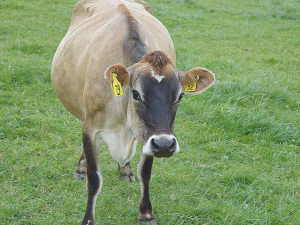2024/25 Dairy Statistics: NZ dairy farmers boost production with fewer cows
According to the New Zealand Dairy Statistics 2024/25 report, New Zealand dairy farmers are achieving more with fewer cows.
 The ability of cows to become pregnant each year to calve in a seasonally concentrated period is critical to the profitability and sustainability of New Zealand's pasture-based systems.
The ability of cows to become pregnant each year to calve in a seasonally concentrated period is critical to the profitability and sustainability of New Zealand's pasture-based systems.
Ground-breaking collaborative research into improving dairy fertility genetics has been recognised in the annual Kudos Awards.
The Improving Dairy Fertility Genetics research project has determined new ways to select inherently fertile cows and that genetic selection for cow fertility will improve herd reproduction.
The project is part of DairyNZ’s Pillars of a New Dairy System research, which has funding from DairyNZ and the Ministry of Business, Innovation and Employment. Additional support comes from AgResearch, LIC, CRV Ambreed and AbacusBio.
“The ability of cows to become pregnant each year to calve in a seasonally concentrated period is critical to the profitability and sustainability of New Zealand’s pasture-based systems,” said project co-leader Dr Susanne Meier.
“It is tremendous to receive this award recognising the value of the research.”
The Kudos Awards recognise eight categories of science excellence for 2020. These apply broadly to all science disciplines and sectors including primary industries, medical, engineering, environmental and education. The project received the primary industries award.
The Improving Dairy Fertility Genetics project uses a genetics approach to help achieve herd reproduction targets by increasing the fertility breeding value’s (BV) accuracy. BV is used to breed dairy cows with superior fertility.
The project aims to improve genetic improvement, by identifying a new range of dairy cow attributes that can be measured earlier. This may significantly accelerate the rate of genetic gain in cow fertility.
“The first phase of the research was an in-depth study where we bred 550 heifers with high and low fertility BV. We worked to understand how they’re different and what is unique to each of them – why are some fertile and some not so fertile, and through this process identified new attributes that have potential for use by the industry,” says Meier.
“We found the high fertility BV heifers reached puberty earlier and lighter than low fertility BV heifers. High fertility BV cows also had a greater ability to resume oestrous cycles post-calving, leading to substantially better submission and 6-week in-calf rates.
“This meant that the high fertility cows recovered from calving very quickly and were receptive to getting in-calf again quickly.”
Once validated on a larger scale, these new reproductive traits can be used by farmers in the future.
The next phase of the research underway now is to seek validation of the traits at a large scale. This involves working with 5000 dairy cows across 54 herds as they go through their first lactation.
The work aims to measure the new attributes of puberty and timing of cycling after calving to confirm the conclusions from the first phase of the research. The project is halfway through the validation work.
“When we get that validation, we can recommend the industry use the puberty trait and other novel measures for better fertility. This is exciting work that could make a big difference in herd reproductive performance,” said project co-leader Dr Chris Burke.
“The project’s research findings are driving industry change and an increasing appreciation of the value of genetics for improving herd reproduction.”
The project is also generating peer-reviewed journal and conference papers, with over 30 published to date.
Three New Zealand agritech companies are set to join forces to help unlock the full potential of technology.
As the sector heads into the traditional peak period for injuries and fatalities, farmers are being urged to "take a moment".
Federated Farmers says almost 2000 farmers have signed a petition launched this month to urge the Government to step in and provide certainty while the badly broken resource consent system is fixed.
Zespri’s counter-seasonal Zespri Global Supply (ZGS) programme is underway with approximately 33 million trays, or 118,800 tonnes, expected this year from orchards throughout France, Italy, Greece, Korea, and Japan.
Animal owners can help protect life-saving antibiotics from resistant bacteria by keeping their animals healthy, says the New Zealand Veterinary Association.
According to analysis by the Meat Industry Association (MIA), New Zealand red meat exports reached $827 million in October, a 27% increase on the same period last year.